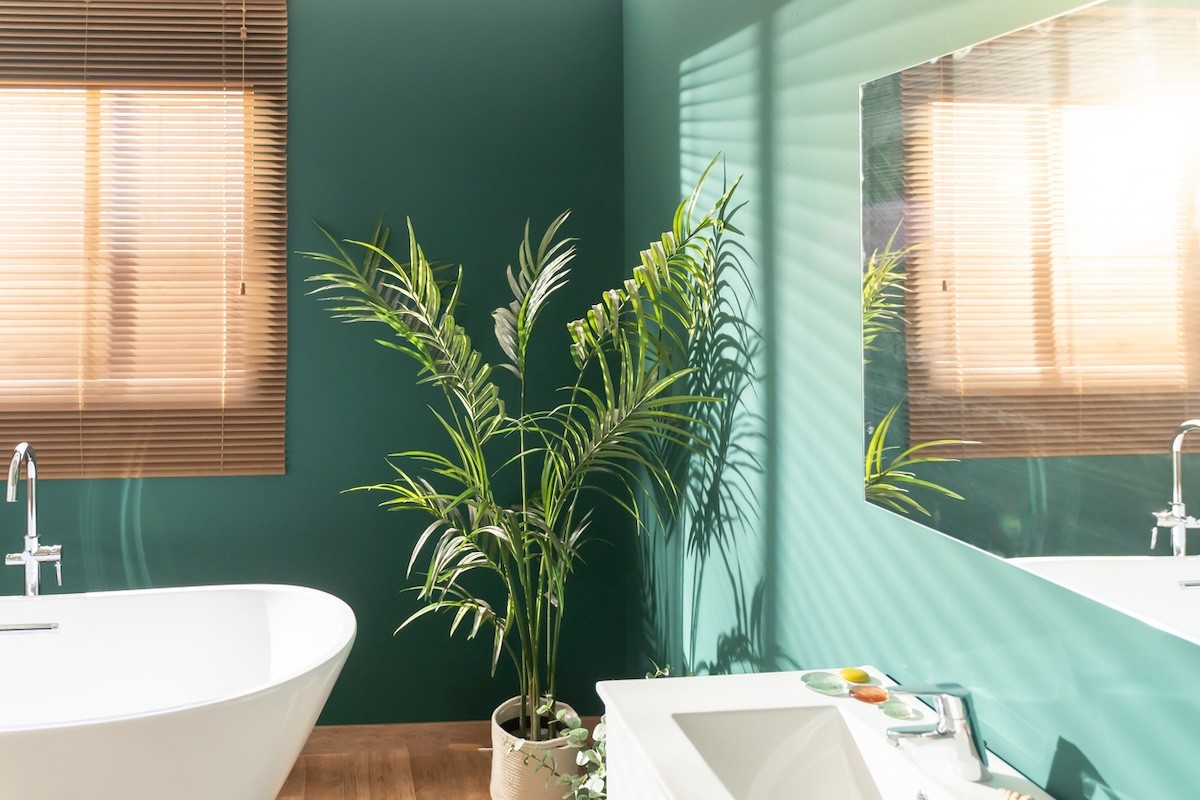These 3 Houseplants Are the “Elegant” Way to Get Rid of Gross Bathroom Smells
They look and work so much better than air freshener sprays and matches.

True houseplant heads know there’s not a single room in the house where a little green won’t go a long way, including the bathroom. They also know that it’s always a good idea to go with options that will thrive in that environment, especially when it comes to a moist, humid environment like the bathroom. But did you know that some houseplants can go even further by getting rid of some of those gross bathroom smells? Some experts say the right species can be an “elegant” solution to a perennial problem. Here are the top three.
RELATED: 12 Easy Houseplants That Don’t Need Sunlight.
1
English ivy

We’ve all resorted to one tactic or another to freshen up the aroma in a bathroom, whether it’s lighting candles, setting up a reed diffuser, or plugging in a scented air freshener. But in a recent video posted to TikTok, houseplant expert account @RootGrowings revealed that you can actually solve the issue by picking one of three species of plant.
The first option is English ivy, a common fixture in homes that already appreciates moisture (though note that it’s toxic to both humans and pets). According to the video, it’s also been proven to remove a remarkable 94 percent of airborne fecal particles in just 12 hours—which is a major help on the odor issue. To get the most out of it, they suggest hanging yours near the toilet.
And that’s not the only benefit they provide: A landmark study conducted by NASA also cited the creeping vine plant as a fantastic filter, finding that it was also helpful in removing 90 percent of toxic benzene from the air produced by tobacco smoke and industrial exhaust. It also slashed the concentration of trichloroethylene (which has been found to damage the immune and reproductive systems and increase the risk of some cancers) by nearly 11 percent.
2
Peace lily

Want to bring even more elegance into your bathroom? @RootGrowings says the Peace Lily is yet another standout stench-stopping plant that looks especially nice while doing its job.
According to the video, the plant “filters ammonia, formaldehyde, and other stink makers.” And of course, there’s also the added benefit of its beautiful white flowers that are a serious step up from your typical toilet decor.
And just English ivy, they’re a good air filter. The same NASA study found that the peace lilies removed nearly 80 percent of benzene from the air. It was also the most effective of any species at cutting down trichloroethylene, dropping it by 23 percent.
RELATED: I Have 300 Houseplants and These Are the Plants “I Just Can’t Stand.”
3
Areca palm

Palms can be one of the best and easiest ways to freshen up a space. But according to @RootGrowings, one species is especially good for bathrooms: The Areca Palm.
According to the video, the plant “absorbs nasty bathroom odors” without resorting to expensive fans or pungent potpourri.
NASA’s research also found some major positives for having Areca Palms around the house, too. Notably, it was one of the most effective species at removing formaldehyde from the air, ultimately working just as well as a mechanical air purifier at the task.
Here are a few more purifying plants you should consider.

Making your washroom smell better is already a huge bonus. But there are other plants that function as living filters to improve air quality all around your home.
If you’re trying to work with the relatively low light conditions that most bathrooms have, you might want to consider Golden Pothos. According to the NASA study, it was a fantastic benzene remover, taking out 73 percent of the toxic compound from the air, as well as formaldehyde and trichloroethylene.
“Pothos is easy to care for and it can tolerate low light well,” Vladan Nikolic, a houseplant expert and founder of the blog Mr. Houseplant, previously told Best Life. “However, if you give it more bright, indirect light it will produce new leaves faster, and the plant will be sturdier and more resilient to pests and diseases.”
Looking for something a little more stark? Ficus (also known as fig trees) are also fantastic at removing toxins from the air, cutting 48 percent of formaldehyde, 30 percent of benzene, and 10.5 percent of trichloroethylene. But their appearance can also be equally impressive.
“These plants can grow between two and 10 feet tall,” Tatyana Zhuk, expert at the Plantum app, previously told Best Life. “They prefer bright indirect sunlight and weekly watering.”





















